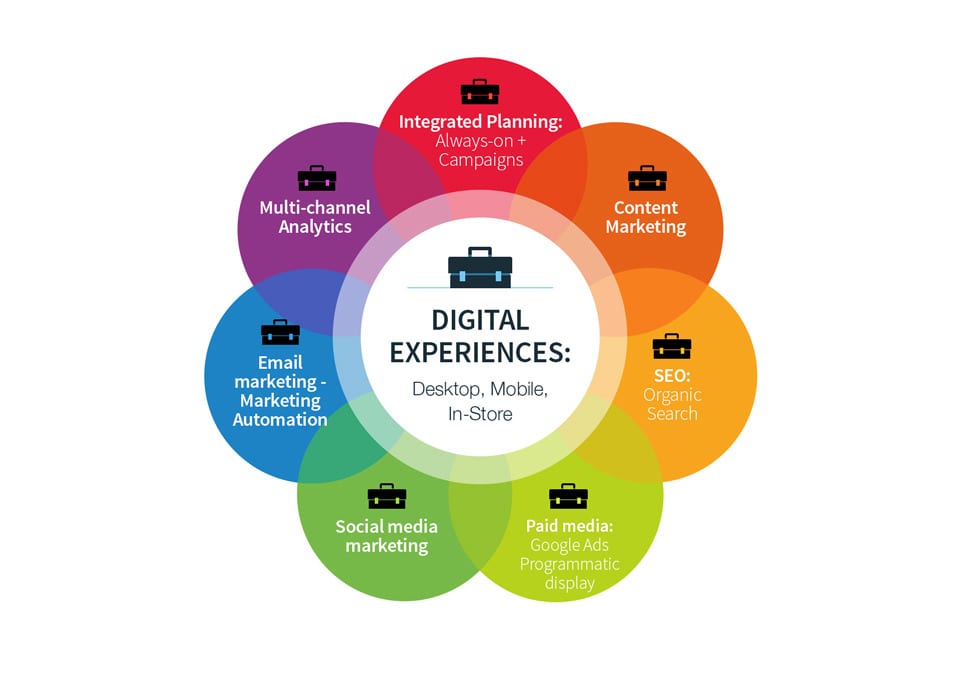Digital marketing has changed how businesses reach and engage with customers and prospects. Using digital marketing effectively can increase sales and spike business growth a lot. We will learn how to make full use of digital marketing to increase sales, focusing on proven strategies and best practices.
Understanding Digital Marketing
Digital marketing encloses all marketing efforts that use the internet and electronic devices. Involving various channels, including search engines, social media, email, websites, and online advertising. The primary goal is to connect with prospects where they spend a significant amount of their time.
Why Digital Marketing is Important
Customers today want interactive experiences. Digital marketing comes with a powerful toolbox for connections. Here’s why it dominates:
- Global Reach: Reach millions across the globe. Social media platforms like Facebook brag over 2.91 billion monthly active users, while search engines process over 5.4 billion searches daily.
- Cost-Effective: Compared to traditional methods, digital marketing can be significantly more budget-friendly. Pay-per-click (PPC) advertising guarantee you only pay when someone clicks on your ad, maximizing the ROI. Email marketing brags an average ROI of 4200%, making it a cost-effective way to nurture leads.
- Measurable Results: Unlike traditional marketing, it offers a wealth of data. Track key metrics like website traffic, user engagement, and conversion rates to fine-tune strategies and eliminate wasteful spending.
- Targeted Advertising: Deliver laser-focused messages directly to your ideal customer. Digital marketing platforms allow you to target users based on demographics, interests, and even purchase history, increasing engagement and conversion rates.
- Flexibility and Adaptability: Unlike static ads, digital campaigns can be easily adjusted based on real-time data. This allows for constant optimization for maximum impact.
Digital marketing offers a powerful and versatile suite of tools to connect with your target audience and achieve sustainable growth.
Key Digital Marketing Strategies for more sales

To maximize sales through the digital marketing, businesses need to implement a variety of strategies that work together easily. Here are some of the most effective approaches:
1. Search Engine Optimization (SEO): Dominating Search Results
SEO is the art and science of optimizing your website to rank higher in search engine results pages (SERPs) for relevant keywords. The higher you rank, the more organic traffic you’ll attract, translating into potential leads and customers. Here are some key SEO tactics to consider:
Keyword Research:
Uncover the search terms your target audience uses with tools like Google Keyword Planner or Ahrefs https://ahrefs.com/. According to a recent study by Search Engine Journal, 49% of marketers say keyword research is the single most important factor in their SEO strategy.
On-Page Optimization:
Craft compelling title tags, meta descriptions, and headers that incorporate your target keywords. Optimize your website’s content to be informative, engaging, and relevant to your audience’s search intent.
Technical SEO:
Make sure your website loads quickly on all devices and has a clear, crawlable site structure. Google Search Console offers free tools to diagnose and fix technical SEO issues.
Content Creation:
Become a thought leader in your industry by consistently publishing high-quality content that addresses your audience’s needs and interests. Hubspot reports that companies that blog 15 times or more per month get 5 times more traffic than those that don’t.
Link Building:
Acquire backlinks from reputable websites to boost your site’s authority and credibility in the eyes of search engines.
2. Content Marketing:
Content marketing focuses on creating and distributing informative and engaging content that attracts and retains your target audience. By establishing yourself as a trusted resource, you can get leads and drive sales. Here are some effective content marketing strategies:
- Blogging: Regularly publish informative blog posts on industry-related topics. Studies show that businesses with active blogs generate up to 434% more qualified leads than those without.
- Ebooks and Whitepapers: Offer downloadable resources packed with valuable insights and solutions to your audience’s pain points.
- Video Content: Create engaging and informative videos (think tutorials, explainer videos, or customer testimonials) to educate and entertain your viewers. Wyzowl reports that 87% of marketers now use video content in their marketing strategy.
- Infographics: Use visually appealing infographics to present your complex information in a clear and concise way.
3. Social Media Marketing: Building Communities and Brand Awareness
Social media platforms offer unmatched potential for connecting with your target audience, building brand awareness, and driving sales. To use social media effectively, consider these key points:
- Platform Selection: Identify the platforms where your target audience spends their time. Popular options include Facebook, Instagram, LinkedIn, and Twitter.
- Content Strategy: Develop a diverse content mix, including engaging posts, stories, videos, and live streams, to keep your audience interested.
- Social Engagement: Respond to comments, messages, and reviews promptly to foster a sense of community and build trust.
- Social Media Advertising: Utilize paid social media advertising to reach a wider audience and achieve specific marketing goals. Social Media Examiner reports that 64% of marketers plan to increase their social media ad spend in 2024.
4. Email Marketing: Nurture Leads and Drive Sales
Despite the rise of new marketing channels, email marketing remains a powerful tool for nurturing leads and converting them into paying customers. Here are some strategies to maximize your email marketing ROI:
- Segmentation: Divide your email list into segments based on demographics, interests, or purchase behavior. This allows you to send targeted emails that resonate with specific audience segments.
- Personalization: Craft personalized emails with greetings, product recommendations, and offers tailored to individual subscribers. Studies show that personalized emails can generate up to 6 times higher click-through rates than generic emails.
- Marketing Automation: Utilize email marketing automation tools to send triggered emails based on subscriber behavior. For instance, you can send a welcome email series to new subscribers or a re-engagement campaign to inactive subscribers.
Compelling Content: Create valuable and engaging email content, including newsletters, promotional offers, and educational content.
5. Pay-Per-Click (PPC) Advertising: Targeted Traffic and Fast Results
PPC advertising allows you to bid on keywords and display targeted ads on search engines or other platforms. When a user clicks on your ad, you pay a fee. PPC can be a great way to drive high-quality traffic to your website and generate leads or sales quickly. Here are some key PPC strategies for success:
- Keyword Selection: Choose relevant keywords with high search volume and a strong conversion intent. Tools like SEMrush [https://semrush.com/] can help you identify profitable keywords.
- Compelling Ad Copy: Write clear, concise, and persuasive ad copy that entices users to click. Highlight your unique selling proposition (USP) and include a strong call to action (CTA).
- Landing Pages: Create high-converting landing pages that are specifically designed to match the intent of your ad copy. Ensure your landing pages are optimized for conversions with clear CTAs and a user-friendly design.
- Bid Management: Monitor your PPC campaigns closely and adjust your bids to maximize your return on investment (ROI).
6. Influencer Marketing:
Influencer marketing involves partnering with social media personalities or industry experts who have a large and engaged following. By leveraging the influencer’s credibility and reach, you can promote your products or services to a targeted audience. Here’s how to make influencer marketing work for you:
- Identify Relevant Influencers: Find influencers whose target audience aligns with your ideal customer profile. Look for influencers who create high-quality content and have a strong engagement rate with their followers.
- Authentic Collaboration: Develop genuine partnerships with influencers. Don’t just focus on a transactional approach. Collaborate on content creation that feels natural and resonates with the influencer’s audience.
- Track Performance: Monitor the results of your influencer marketing campaigns. Track metrics such as brand mentions, website traffic, and sales conversions to measure the campaign’s effectiveness.
A well-rounded digital marketing strategy isn’t built on a single channel. By combining these powerful tactics and personalizing them to your specific business goals and target audience, you can create a detailed approach that drives traffic, generates leads, and ultimately increases sales. Remember, consistency and ongoing optimization are key to maximizing your ROI.
For more information: https://www.smartinsights.com/managing-digital-marketing/marketing-innovation/business-critical-digital-marketing-trends/
Integrating Digital Marketing Strategies

To achieve the best results, integrate various marketing strategies into a close-knit plan:
1. Chart Your Course: Building a Comprehensive Digital Marketing Plan
- Goal Setting: Define your digital marketing objectives with the SMART method). You want to increase brand awareness by 20% in six months? Generate more qualified leads? Drive a specific amount of website traffic? Clearly defined goals will guide your entire strategy.
- Know Your Audience: Buyer personas are detailed profiles of your ideal customers. Understanding their demographics, online behavior, and pain points allows you to personalize your messaging and content for maximum impact.
- Resource Allocation: Determine your budget and allocate resources effectively across different channels. Consider factors like platform advertising costs, content creation expenses, and any necessary marketing automation tools.
Identify KPIs to gauge the success of your campaigns. Track website traffic, lead generation, conversion rates, social media engagement, and other relevant metrics depending on your goals.
2. Maintaining Brand Consistency
Encountering a brand with a different logo and messaging on every platform they use. Disjointed branding can confuse your audience and hinder trust-building. To establish a strong brand identity, ensure consistency across all digital touchpoints:
- Visual Identity: Maintain a consistent visual style guide that includes your brand logo, color palette, typography, and imagery. This creates a recognizable visual language for your brand.
- Brand Voice: Have a distinct brand voice that reflects your brand personality. Are you playful and informative? Sophisticated and authoritative? A consistent voice strengthens brand recognition and builds trust with your audience.
- Messaging Alignment: Ensure your messaging across all channels reinforces your brand’s core values and offerings. Tailor the message format for each platform, but keep the core message consistent.
3. Use the Power of Data: Data-Driven Decisions
Data is the fuel that propels successful digital marketing campaigns. Utilize analytics tools to glean valuable insights into user behavior:
- Website Analytics: Track website traffic sources, user engagement with your content, and conversion rates. Tools like Google Analytics provide a wealth of data to understand how users interact with your website.
- Social Media Analytics: Monitor social media platform insights to see which content resonates with your audience and identify opportunities to improve engagement.
- Campaign Performance Tracking: Analyze the effectiveness of your campaigns across different channels. See which tactics generate the most leads or sales and optimize your budget allocation accordingly.
By making use of data strategically, you can move beyond guesswork and make informed decisions that maximize your ROI.
Continuous Testing and Improvement:
The digital marketing landscape is constantly evolving, and what works today might not be effective tomorrow. Be prepared to adapt and refine your strategies continuously through A/B testing:
- Test Different Approaches: Run A/B tests to compare the effectiveness of different headlines, ad copy variations, landing page designs, or email subject lines. See which version resonates better with your audience and drives higher engagement or conversions.
- Stay Agile: Be willing to adapt your strategies based on the data you collect. If a particular channel isn’t yielding desired results, don’t be afraid to shift resources or experiment with new tactics.
More info: https://www.linkedin.com/pulse/what-integrated-digital-marketing-gideon-banks/
Case Studies: Success Stories
Case Study: B2B Lead Generation – Fueling the Pipeline with Targeted Strategies
Challenge:
Acme Inc., a B2B software company specializing in marketing automation solutions, struggled to generate qualified leads. Their website received decent traffic, but very few visitors converted into leads. The marketing team lacked a targeted approach to reach key decision-makers within their target industries.
Solution:
Acme implemented a multi-pronged digital marketing strategy focused on lead generation:
- Content Marketing with Lead Magnets: The company pivoted their content strategy to create high-value content specifically designed to attract their ideal customer profile. They developed informative white papers, industry trend reports, and downloadable case studies. Each piece of content offered valuable insights and solutions to common pain points experienced by their target audience. In exchange for downloading these resources, visitors were required to submit their contact information, effectively converting them into qualified leads.
- Targeted LinkedIn Lead Generation: Acme recognized the professional networking platform, LinkedIn, as a goldmine for reaching B2B decision-makers. They leveraged LinkedIn’s powerful advertising tools to run targeted ad campaigns focused on specific industries, job titles, and company sizes. Their ad copy highlighted the benefits of their marketing automation solution and included compelling calls to action, like “Download our free white paper on boosting marketing ROI.” These targeted ads drove qualified traffic to their landing pages designed to capture leads.
- Nurturing Leads with Email Marketing: Once a lead entered Acme’s funnel, they nurtured them through a series of automated email sequences. These emails provided valuable content, product demos, and educational resources relevant to the lead’s interests. The emails also offered free consultations with Acme’s sales team, further progressing leads down the sales funnel.
Results:
Within six months of implementing this comprehensive B2B lead generation strategy, Acme achieved significant results:
- Increased Qualified Leads by 75%: Their targeted content marketing and LinkedIn advertising campaigns significantly boosted the number of qualified leads entering their sales pipeline.
- Improved Lead Conversion Rate by 20%: By nurturing leads with relevant content and personalized email communication, Acme converted a higher percentage of leads into paying customers.
- Shorter Sales Cycle: By providing valuable resources and addressing pain points early on, Acme streamlined the sales cycle, enabling them to close deals faster.
Key Takeaways: This case study demonstrates the power of a targeted digital marketing strategy for B2B lead generation. By combining high-value content, strategic social media advertising, and nurturing email campaigns, Acme was able to attract qualified leads, improve conversion rates, and shorten their sales cycle.
Conclusion
Digital marketing is a powerful tool for boosting sales, but managing it all can be overwhelming. CloudArk is your secret weapon.
This cloud-based platform simplifies SEO, content management, and social media. Plus, CloudArk unifies data and automates tasks, freeing you to focus on strategy. Run targeted ads and track ROI, all in one place
You might also want to know ‘How Digital Marketing Can Transform Your Business’
FAQ
Digital marketing provides a wealth of data. Track website traffic, user engagement, conversion rates, and other relevant metrics to see what's working and what needs improvement.
It depends on your strategy. SEO and content marketing are a long-term game, building brand awareness and organic traffic over time. Paid advertising like social media ads can deliver faster results, but require ongoing investment. The key is consistency – continuously create valuable content, optimize your campaigns, and track your progress.
Absolutely! Organic SEO tactics like keyword research and on-page optimization are free to implement. Engaging social media content and email marketing don't require a hefty budget either. As you gain traction, you can explore paid advertising for targeted reach.

